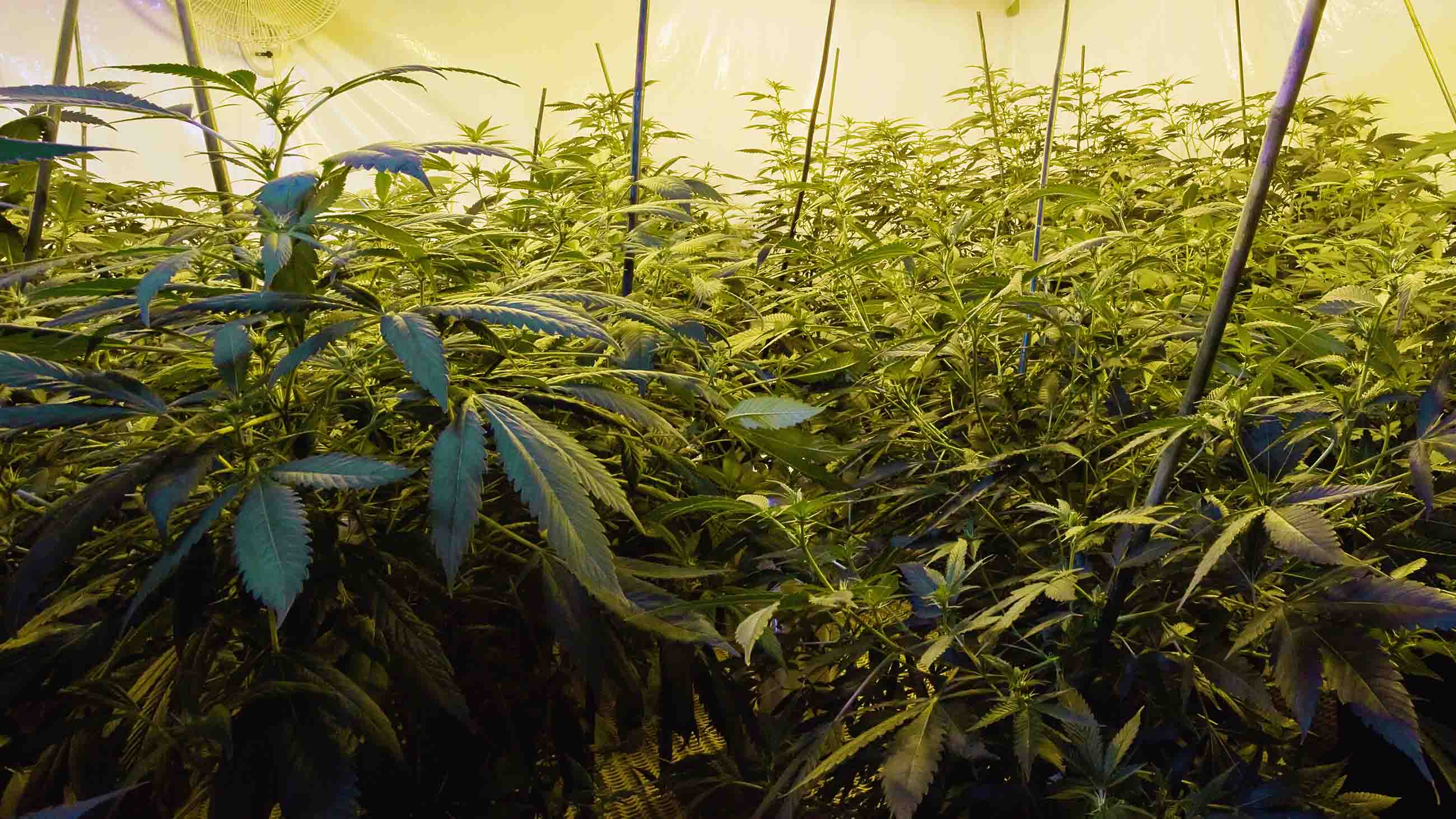For Medical Marijuana, Is it the Whole Plant That Matters?
Tracy Dixon-Salazar nearly fainted the first time her two-year old daughter Savannah had a seizure. While calling 911, the panicking mother grew hot and lay down on the floor. Savannah recovered, but the seizures later returned — and they came more frequently.
“By age three, she was seizing uncontrollably,” says Dixon-Salazar, director of research and strategy at the Lennox-Gastaut Syndrome Foundation. “By age five, she was diagnosed with LGS and completely had her entire life robbed from her.”
LGS, or Lennox-Gastaut Syndrome, is a rare and difficult to treat form of epilepsy that appears in childhood. It severely diminishes quality of life and is characterized by frequent treatment-resistant seizures and cognitive impairment. For many LGS patients, the cause is multifaceted or elusive — in approximately 35 percent of cases, no source is identified.
Treatment is just as evasive. For all the anesthetics, anticonvulsants, steroids, and myriad other pharmacological agents regularly prescribed for LGS, no single drug has been shown to be highly effective. Because the cause and severity of the disease differs between patients, doctors usually prescribe some combination of medications — and another option will soon be available.
On Monday, a new epilepsy drug was approved by the Food and Drug Administration — making it the first derived from cannabis to be available on the U.S. market. Called Epidiolex, the drug (which contains cannabidiol, or CBD, along with a proprietary blend of chemicals) is designed to treat LGS and Dravet Syndrome, another severe epileptic condition characterized by batteries of treatment-resistant seizures.
“This approval serves as a reminder that advancing sound development programs that properly evaluate active ingredients contained in marijuana can lead to important medical therapies,” FDA Commissioner Scott Gottlieb said in a statement.
While the FDA has previously approved two cannabis-based medications for different conditions, they contain synthetic versions of THC, the cannabis component that gets people high. Some scientists see the focus on such singular elements as misguided. Through legal or quasi-legal markets, cannabis has long-been used by epilepsy patients, and while current understanding is limited due to research restrictions, many of its therapeutic effects may rest on the power of the plant as a whole — a concept known as the “entourage effect.”
“The entourage effect is simply the idea that multiple compounds can act in concert or in synergy with one another to produce different effects,” said Nick Jikomes, a neuroscientist and the principal research scientist at Leafly, the world’s largest cannabis website. While it has some validity, he said, “there’s limited experimental evidence that really nails it down or tells us exactly what those interactions are.”
Epidiolex consists of 98 percent CBD, but the remaining 2 percent — the makeup of which its manufacturer GW Pharmaceuticals would not disclose — could make a significant difference, Jikomes said.
“If it didn’t matter, why would it be a secret?” he questioned.
To date, the entourage effect is not considered accepted science, though that may be due in part to the alleged phenomenon’s connection to cannabis. Under federal law, marijuana is classified as a Schedule I drug — the same category as heroin, LSD, and other drugs considered by the government to have no medical benefit and a high potential for abuse. That doesn’t mean that research on the medicinal qualities of marijuana, or even the purported mechanics of the entourage effect, are wholly off-limits. There are just additional regulatory barriers with less access to funding and samples, so many researchers become discouraged or don’t bother trying.
Even so, while many scientists insist that evidence to support the existence of the entourage effect is lacking, others are staunch in their belief that it could play a significant role in potential medical applications of the controversial plant going forward — though they admit there is still much more to learn.
“Although many scientists — and even more non-scientists — use this term, we know very little about it,” said Raphael Mechoulam, the Israeli chemist who introduced the term along with his colleague Shimon Ben-Shabat. “Which non-cannabinoids are involved? Which cannabinoid effects are subject to the entourage effects?”
The use of cannabis to treat epilepsy dates back several centuries, though the exact mechanisms involved are still being studied. Some researchers predict it may have to do with several neural pathways cannabinoids potentially target, such as GABAA receptors, which are involved in seizure disorders.
“Investigation into dose response and interaction effects of different cannabis compounds and their various combinations are warranted,” neurologists wrote in a 2017 paper reviewing fMRI studies using cannabinoids to treat epilepsy. “Because of the possibility of an entourage effect, while the efficacy of combinations of phytocannabinoids is being examined, the effects of such combinations on brain and behavior in patients with epilepsy need to be investigated in parallel.”
In Epidiolex, such a combination could include THC, CBN or CBDV, cannabinoids also shown to have anticonvulsant effects in animal models. Or, it could include linalool, an organic chemical called a terpenoid that is found in cannabis, basil, and 200 other plants. Linalool, in combination with other plant extracts, has also been shown to dampen seizures in mice and rats. Epidiolex could contain all of these (a press release from the manufacturer in May hinted that it does contain at least some THC), or a totally different combination of cannabis chemicals.
Steve Schultz, vice president of investor relations at GW Pharmaceuticals, said the term entourage effect is bounced around a lot. “I’m not sure … whether there’s a clear definition what it means,” Schultz explained in a call. “But in our studies and in our development process, we use science as a foundation for how we develop our medicine. We look at various cannabinoids, either individually or together, we test those against various preclinical models to give us a sense for whether or not they may be effective in humans.”
While Schultz wouldn’t directly say if the effect plays a role in new drug, he did mention Sativex, another drug developed by the company, which contains a balanced ratio of THC and CBD for treating multiple sclerosis symptoms. “We believe that chemical composition is ideal for that therapeutic target,” he said.
The origin of the term “entourage effect” is fairly straightforward — it was first described by Mechoulam and Ben-Shabat 20 years ago in a paper published in the European Journal of Pharmacology. Mechoulam, who discovered THC in 1964, and Ben-Shabat describe the synergetic relationship of endocannabinoids, chemicals that the body naturally produces similar to phytocannabinoids from the plant.
The phenomenon has since become shorthand in some circles to explain the belief that marijuana extracts are more efficacious than synthetic cannabinoids. It’s also used to attempt to explain why certain marijuana strains will have opposing effects — some high THC chemotypes can be energizing, while high CBD strains are generally more sedating and anxiolytic. The problem is the lack of research in this area, or as Jikomes put it, “The folklore often moves faster than the facts.”
While medical marijuana programs in the U.S., pioneered in California in 1996, bring to mind images of dried marijuana buds, high-dose pot cookies, and gooey dabs of cannabis oil, the two synthetic cannabis-based pharmaceuticals in the U.S. received FDA approval back in 1985. The first, dronabinol, is a pure isomer of THC used to treat chemotherapy-related nausea and stimulate the appetite of anorexic patients with HIV and AIDS. There’s also nabilone, a THC-mimicking analgesic prescribed for severe nausea.
If cannabis-based prescriptions have existed for decades, why haven’t they replaced less-regulated marijuana programs that remain illegal under federal law? Some experts argue it again has to do with the entourage effect.
“Big Pharma does not understand botanical medicine,” said Ethan Russo, a neurologist and former medical advisor at GW Pharmaceuticals who now serves as director of research and development at the International Cannabis and Cannabinoids Institute. Pointing to the ineffectiveness or side effects in pure or synthetic cannabinoids, he cited rimonabant, a weight-loss drug and “anticannabinoid” that selectively blocks cannabinoid receptors in the body. Europe approved its use in 2006, but rimonabant was soon yanked from the shelves after being linked to “severe psychiatric adverse reactions,” including suicide.
In a 2011 paper, Russo examined the potential synergy of phytocannabinoids with terpenoids. For example, myrcene, a sedating terpenoid, combined with THC may generate the immobilizing “couch-lock” sensation some experience under the influence of cannabis.
“I can tell you having worked with GW, they were sure aware of [the entourage effect],” Russo added.
On Monday, the U.S. Food and Drug Administration approved the first cannabis-derived drug in the country for use in treating two severe epilepsy disorders.
This week’s approval of Epidiolex was anticipated, as the drug received unanimous support from a FDA advisory board in April, a vote of 13 to 0. GW Pharmaceuticals has also presented their medication to the European Medicines Agency for review. The company expects approval by that agency in the first quarter of 2019.
In a phase 3 clinical trial published in The New England Journal of Medicine in May, Epidiolex reduced drop seizures in LGS patients taking 20 mg per kilogram of body weight each day by nearly 42 percent, while eight patients stopped having drop seizures altogether during the maintenance phase. GW published similar results a few months earlier in The Lancet, showing, with the same dosage, an almost 44 percent reduction in drop seizures. The company also funded a double-blind, placebo-controlled clinical trial for Dravet syndrome, published in the NEJM last year.
Before Epidiolex, there were no drugs were approved specifically for treating Dravet — and treating LGS is complicated and often ineffective. Because patients often take a combination of different medications, it’s difficult to compare the effectiveness of Epidiolex to what’s already on the market.
The results also don’t point to Epidiolex as a one-stop cure, but rather an addition to the limited pharmacopeia of epilepsy drugs. “The thing that’s going to work for different people will vary depending on what the cause of their [LGS] is,” Dixon-Salazar said. “There are a thousand different causes: genetics, metabolic, injury, infection, tumor, stroke at birth…”
Usually once caretakers find a preparation or drug combination that significantly reduces seizures, they are reluctant to change protocols. In her case, Dixon-Salazar put Savannah on a calcium channel blocker, which reduced her seizures by 95 percent.
“She has about two to four seizures a week at night only, which is too many in a lifetime, but compared to what it was before…,” Dixon-Salazar says. “We actually have been thinking about trying the GW product when it comes out, but again, we don’t want to rock the boat.”
Still, Dixon-Salazar says, the development of a new treatment for the disease is certainly welcomed by the epilepsy community.
“In all honesty, anytime a new drug comes out for LGS and for Dravet,” she says, “we just are like, ‘Thank God that somebody cares.’”
While CBD, along with the marijuana plant itself, is still listed as a Schedule I controlled substance by the Drug Enforcement Administration, the approval of Epidiolex could have far-reaching effects on cannabis policy and prescription drug manufacturing, some scientists say, by opening the door for other botanical drugs. (The DEA will likely reclassify CBD within 90 days.)
“I can understand, as a scientist, the traditional pharmaceutical approach to drug development, which is one drug in pure form at very precise dosages,” Jikomes says. “But when you look at nature, plants and animals are typically not interacting with biologically-active compounds in pure form, one at a time. They’re interacting with and deploying cocktails of compounds in combination to achieve certain ecological functions, so it makes a lot of sense that combinations of drugs will have a different effect than pure compounds.”
Efforts to bolster the entourage effect theory reflect a wave of changing attitudes across the U.S. about cannabis used as medicine. Whether or not the idea turns out to be scientifically valid — or to contribute to the effectiveness of Epidiolex — the drug’s approval, Jikomes say, could not only soften attitudes about medical marijuana, but could also motivate politicians and other policymakers to update their viewpoints to reflect public opinion.
Regardless, FDA-approval of drugs like Epidiolex are seen as beneficial, Dixon-Salazar says, especially because they can help those not “necessarily equipped to figure out dosing or which product is good versus which product is snake oil.
“It’s not gonna be the saving grace for every LGS family or every family with epilepsy,” she adds, “but it’s another choice.”
Troy Farah is an independent journalist from California. His reporting and criticism covering drug policy, science, and harm reduction has been published in Smithsonian, Discover, The Outline, VICE, and others. He can be reached on Twitter at @filth_filler.
UPDATE: This story has been updated to clarify that the human body contains receptors for cannabinoids, rather than cannabis specifically.











Comments are automatically closed one year after article publication. Archived comments are below.
As A biologist I am facinated by the bio-chemstry of the Endocannabinoid System which I only discovered recently. There is an excuse for me not knowing as it is over 30 years since I did my degree and has only been known for about 20 years but why it not been taught in schools, colleges, Universities or Medical Schools now? Until “Jo Bloggs” understands how it moderates homeostasis in our bodies and if there is a deficiency serous problems occur which cannabis can fix.I’d heard about the Israeli work on crones and cannabis relieving symtoms of crones. My mum was diagnosed with crones at 80. Having lost her mum and sister, with what in retrospect was probably undiagnosed crones, thought it could be gentic decided that I would move to Spain where cannabis was legal. We will get Medicinal cannabis in U.K. and hopfully more research into all aspects of this ancient medecine can go ahead. I would rather have decriminisation than legalisation. Legalistion will just have large pharma companies with more than 45 acres of greenhouse full of cannabis plants and taxed to the hilt. Theresa needs to plug the hole in tha NHS in some way! With 22% of GW’s shares Philip’s company will not missout so instead of selling it abroad some may have to stay here. I am closely involved as I have a friend whose only son has Menkes disease that is life limitng and maybe the cannabis oil could control his seizures until he can have gene therapy. I lost my son in a tragic accident last year so I know what is feels like but they live 24/7 knowing that their precious baby could die at anytime. Let him have a chance to give more than two years memories, I have 40 and that wasn’t enough.